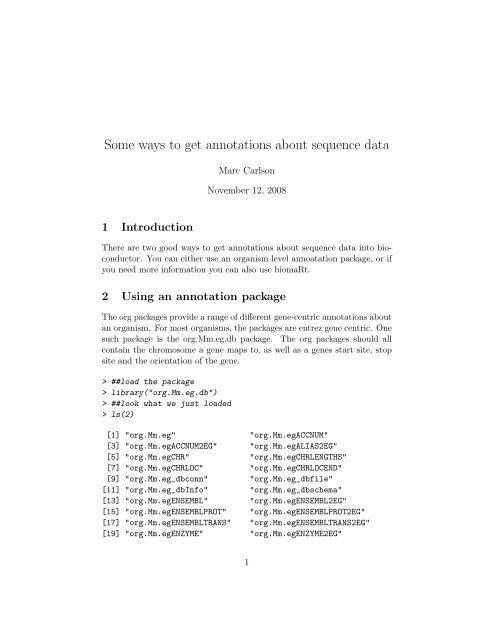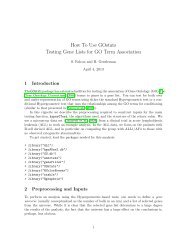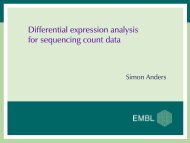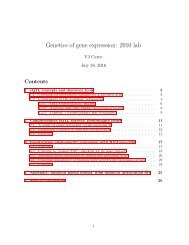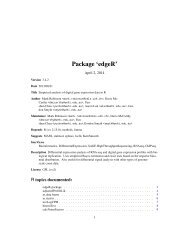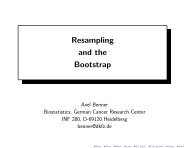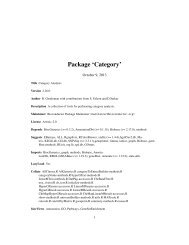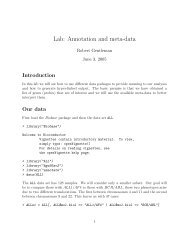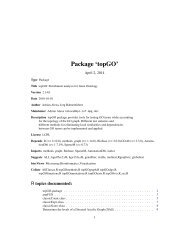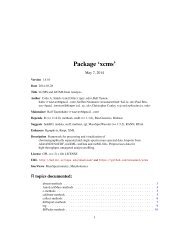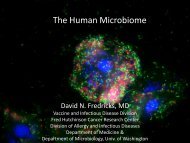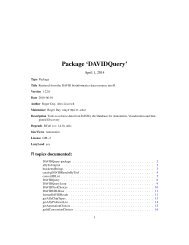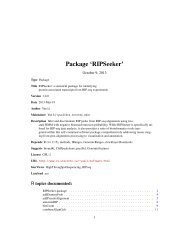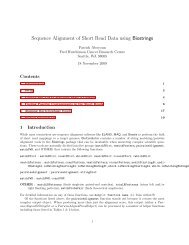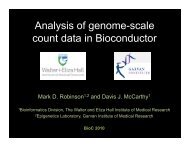Annotation of Sequencing Data - Bioconductor
Annotation of Sequencing Data - Bioconductor
Annotation of Sequencing Data - Bioconductor
Create successful ePaper yourself
Turn your PDF publications into a flip-book with our unique Google optimized e-Paper software.
Some ways to get annotations about sequence data<br />
Marc Carlson<br />
November 12, 2008<br />
1 Introduction<br />
There are two good ways to get annotations about sequence data into bioconductor.<br />
You can either use an organism level annoatation package, or if<br />
you need more information you can also use biomaRt.<br />
2 Using an annotation package<br />
The org packages provide a range <strong>of</strong> different gene-centric annotations about<br />
an organism. For most organisms, the packages are entrez gene centric. One<br />
such package is the org.Mm.eg.db package. The org packages should all<br />
contain the chromosome a gene maps to, as well as a genes start site, stop<br />
site and the orientation <strong>of</strong> the gene.<br />
> ##load the package<br />
> library("org.Mm.eg.db")<br />
> ##look what we just loaded<br />
> ls(2)<br />
[1] "org.Mm.eg" "org.Mm.egACCNUM"<br />
[3] "org.Mm.egACCNUM2EG" "org.Mm.egALIAS2EG"<br />
[5] "org.Mm.egCHR" "org.Mm.egCHRLENGTHS"<br />
[7] "org.Mm.egCHRLOC" "org.Mm.egCHRLOCEND"<br />
[9] "org.Mm.eg_dbconn" "org.Mm.eg_dbfile"<br />
[11] "org.Mm.eg_dbInfo" "org.Mm.eg_dbschema"<br />
[13] "org.Mm.egENSEMBL" "org.Mm.egENSEMBL2EG"<br />
[15] "org.Mm.egENSEMBLPROT" "org.Mm.egENSEMBLPROT2EG"<br />
[17] "org.Mm.egENSEMBLTRANS" "org.Mm.egENSEMBLTRANS2EG"<br />
[19] "org.Mm.egENZYME" "org.Mm.egENZYME2EG"<br />
1
[21] "org.Mm.egGENENAME" "org.Mm.egGO"<br />
[23] "org.Mm.egGO2ALLEGS" "org.Mm.egGO2EG"<br />
[25] "org.Mm.egMAP" "org.Mm.egMAP2EG"<br />
[27] "org.Mm.egMAPCOUNTS" "org.Mm.egMGI"<br />
[29] "org.Mm.egMGI2EG" "org.Mm.egORGANISM"<br />
[31] "org.Mm.egPATH" "org.Mm.egPATH2EG"<br />
[33] "org.Mm.egPFAM" "org.Mm.egPMID"<br />
[35] "org.Mm.egPMID2EG" "org.Mm.egPROSITE"<br />
[37] "org.Mm.egREFSEQ" "org.Mm.egREFSEQ2EG"<br />
[39] "org.Mm.egSYMBOL" "org.Mm.egSYMBOL2EG"<br />
[41] "org.Mm.egUNIGENE" "org.Mm.egUNIGENE2EG"<br />
[43] "org.Mm.egUNIPROT"<br />
> ##<strong>Data</strong> for the org packages comes from the latest UCSC data<br />
> ##which is from NCBI (UCSC calls it mm9, NCBI Build 37.1)<br />
><br />
> ##Have a peak:<br />
> as.list(org.Mm.egCHRLOC)[1:4]<br />
$`100008564`<br />
[1] NA<br />
$`100008567`<br />
[1] NA<br />
$`100009600`<br />
9<br />
-20866836<br />
$`100009609`<br />
7<br />
-92088678<br />
> ##Notice For each entrez gene ID, there is a start location for the UCSC genome<br />
> ## negative values are the minus strand<br />
> ## positve values are the positive strand<br />
><br />
> ## for the stop locations use:<br />
> as.list(org.Mm.egCHRLOCEND)[1:4]<br />
$`100008564`<br />
[1] NA<br />
2
$`100008567`<br />
[1] NA<br />
$`100009600`<br />
9<br />
-20871537<br />
$`100009609`<br />
7<br />
-92112519<br />
> ##or can use get, mget etc. with the entrez gene ID<br />
> EGs = c("18392","18414","56513")<br />
> mget(EGs, org.Mm.egCHRLOC, ifnotfound=NA)<br />
$`18392`<br />
4<br />
108252058<br />
$`18414`<br />
15<br />
-6763576<br />
$`56513`<br />
8 8<br />
108225548 108225053<br />
> mget(EGs, org.Mm.egCHRLOCEND, ifnotfound=NA)<br />
$`18392`<br />
4<br />
108287436<br />
$`18414`<br />
15<br />
-6824313<br />
$`56513`<br />
8 8<br />
108227394 108227394<br />
3
##You can also retrieve ENSEMBL IDs using this package<br />
> mget(EGs, org.Mm.egENSEMBL, ifnotfound=NA)<br />
$`18392`<br />
[1] "ENSMUSG00000028587"<br />
$`18414`<br />
[1] "ENSMUSG00000022146"<br />
$`56513`<br />
[1] "ENSMUSG00000005699"<br />
3 Using biomaRt<br />
If you can’t find what you are looking for in the annotation packages, you can<br />
also consider trying biomaRt. biomaRt is slower, not versioned, and requires<br />
a greater level <strong>of</strong> knowledge to use, but sometimes there is information there<br />
that is not included in the annoation packages yet. An example <strong>of</strong> this are the<br />
exon boundaries. One thing to pay attention to is that the biomaRt ensembl<br />
database used in this example is a different source <strong>of</strong> annotations from the<br />
annotation packages above (which come from UCSC). So we recommend<br />
against mixing and matching these two annotation sets as there might be<br />
disagreements.<br />
Remember also when using biomaRt, that it has to talk to an external<br />
server most <strong>of</strong> the time. So you may have to repeat some <strong>of</strong> the following<br />
steps if the internet is not cooperating.<br />
> ##Getting the data from biomaRt:<br />
><br />
> library("biomaRt")<br />
> ##Choose a database<br />
> listMarts()[1:5,]<br />
biomart<br />
version<br />
1 ensembl ENSEMBL 50 GENES (SANGER UK)<br />
2 snp ENSEMBL 50 VARIATION (SANGER UK)<br />
3 vega VEGA 32 (SANGER UK)<br />
4 msd MSD PROTOTYPE (EBI UK)<br />
5 uniprot UNIPROT PROTOTYPE (EBI UK)<br />
4
##Get the current ensembl database.<br />
> ensembl = useMart("ensembl")<br />
> ##List the datasets therein<br />
> list<strong>Data</strong>sets(ensembl)[1:10,]<br />
dataset description version<br />
1 oanatinus_gene_ensembl Ornithorhynchus anatinus genes (OANA5) OANA5<br />
2 cporcellus_gene_ensembl Cavia porcellus genes (GUINEAPIG) GUINEAPIG<br />
3 gaculeatus_gene_ensembl Gasterosteus aculeatus genes (BROADS1) BROADS1<br />
4 lafricana_gene_ensembl Loxodonta africana genes (BROADE1) BROADE1<br />
5 agambiae_gene_ensembl Anopheles gambiae genes (AgamP3) AgamP3<br />
6 mlucifugus_gene_ensembl Myotis lucifugus genes (MICROBAT1) MICROBAT1<br />
7 hsapiens_gene_ensembl Homo sapiens genes (NCBI36) NCBI36<br />
8 aaegypti_gene_ensembl Aedes aegypti genes (AaegL1) AaegL1<br />
9 csavignyi_gene_ensembl Ciona savignyi genes (CSAV2.0) CSAV2.0<br />
10 fcatus_gene_ensembl Felis catus genes (CAT) CAT<br />
> ##Then set up so that you use that for this session<br />
> ##(we will choose the mouse one from NCBI build 37.1):<br />
> ensembl = use<strong>Data</strong>set("mmusculus_gene_ensembl",mart=ensembl)<br />
> ##List attributes<br />
> attributes = listAttributes(ensembl)<br />
> attributes[1:10,]<br />
name description<br />
1 affy_mg_u74a Affy mg u74a<br />
2 affy_mg_u74av2 Affy mg u74av2<br />
3 affy_mg_u74b Affy mg u74b<br />
4 affy_mg_u74bv2 Affy mg u74bv2<br />
5 affy_mg_u74c Affy mg u74c<br />
6 affy_mg_u74cv2 Affy mg u74cv2<br />
7 affy_moe430a Affy moe430a<br />
8 affy_moe430b Affy moe430b<br />
9 affy_moex_1_0_st_v1 AFFY MoEx<br />
10 affy_mogene_1_0_st_v1 AFFY MoGene<br />
> ##And filters<br />
> filters = listFilters(ensembl)<br />
> filters[1:10,]<br />
name<br />
description<br />
1 affy_mg_u74a Affy mg u74a ID(s)<br />
5
2 affy_mg_u74av2 Affy mg u74av2 ID(s)<br />
3 affy_mg_u74b Affy mg u74b ID(s)<br />
4 affy_mg_u74bv2 Affy mg u74bv2 ID(s)<br />
5 affy_mg_u74c Affy mg u74c ID(s)<br />
6 affy_mg_u74cv2 Affy mg u74cv2 ID(s)<br />
7 affy_moe430b Affy moe430b ID(s)<br />
8 affy_mouse430_2 Affy mouse430 2 ID(s)<br />
9 affy_mouse430a_2 Affy mouse430a 2 ID(s)<br />
10 affy_mu11ksuba Affy mu11ksuba ID(s)<br />
> ##Some entrez gene IDs<br />
> EGs = c("18392","18414","56513")<br />
> ##1st a Simple example to just get some gene names:<br />
> getBM(attributes = "external_gene_id",<br />
+ filters = "entrezgene",<br />
+ values = EGs,<br />
+ mart=ensembl)<br />
external_gene_id<br />
1 Orc1l<br />
2 Osmr<br />
3 Pard6a<br />
> ##Transcript starts and ends:<br />
> getBM(attributes = c("entrezgene","transcript_start","transcript_end"),<br />
+ filters = "entrezgene",<br />
+ values = EGs,<br />
+ mart=ensembl)<br />
entrezgene transcript_start transcript_end<br />
1 18392 108252066 108288633<br />
2 18414 6763590 6824283<br />
3 56513 108225054 108227393<br />
4 56513 108225571 108227393<br />
5 56513 108225571 108227262<br />
> ##Additionally, you can get exon boundaries.<br />
> ##But 1st you have to find out what the attributes are called...<br />
> attributeSummary(ensembl)<br />
category<br />
group<br />
1 Features EXTERNAL:<br />
6
2 Features GENE:<br />
3 Features PROTEIN:<br />
4 Homologs AEDES ORTHOLOGS:<br />
5 Homologs ANOPHELES ORTHOLOGS:<br />
6 Homologs ARMADILLO ORTHOLOGS:<br />
7 Homologs BUSHBABY ORTHOLOGS:<br />
8 Homologs CAT ORTHOLOGS:<br />
9 Homologs CHICKEN ORTHOLOGS:<br />
10 Homologs CHIMP ORTHOLOGS:<br />
11 Homologs CIONA INTESTINALIS ORTHOLOGS:<br />
12 Homologs CIONA SAVIGNYI ORTHOLOGS:<br />
13 Homologs COMMON SHREW ORTHOLOGS:<br />
14 Homologs COW ORTHOLOGS:<br />
15 Homologs DOG ORTHOLOGS:<br />
16 Homologs DROSOPHILA ORTHOLOGS:<br />
17 Homologs C.ELEGANS ORTHOLOGS:<br />
18 Homologs ELEPHANT ORTHOLOGS:<br />
19 Homologs FUGU ORTHOLOGS:<br />
20 Homologs STICKLEBACK ORTHOLOGS:<br />
21 Homologs GUINEA PIG ORTHOLOGS:<br />
22 Homologs HEDGEHOG ORTHOLOGS:<br />
23 Homologs GENE:<br />
24 Homologs HORSE ORTHOLOGS<br />
25 Homologs HUMAN ORTHOLOGS:<br />
26 Homologs MEDAKA ORTHOLOGS:<br />
27 Homologs MICROBAT ORTHOLOGS:<br />
28 Homologs MOUSELEMUR ORTHOLOGS<br />
29 Homologs PARALOGS:<br />
30 Homologs OPOSSUM ORTHOLOGS:<br />
31 Homologs ORANGUTAN ORTHOLOGS<br />
32 Homologs PIKA ORTHOLOGS<br />
33 Homologs PLATYPUS ORTHOLOGS:<br />
34 Homologs RABBIT ORTHOLOGS:<br />
35 Homologs RAT ORTHOLOGS:<br />
36 Homologs RHESUS ORTHOLOGS:<br />
37 Homologs SQUIRREL ORTHOLOGS:<br />
38 Homologs TENREC ORTHOLOGS:<br />
39 Homologs TETRAODON ORTHOLOGS:<br />
40 Homologs TREE SHREW ORTHOLOGS:<br />
41 Homologs XENOPUS ORTHOLOGS:<br />
7
42 Homologs YEAST ORTHOLOGS:<br />
43 Homologs ZEBRAFISH ORTHOLOGS:<br />
44 Sequences SEQUENCES:<br />
45 Sequences Header Information<br />
46 SNPs GENE ASSOCIATED SNPS:<br />
47 SNPs GENE:<br />
48 Structures EXON:<br />
49 Structures GENE:<br />
> ##Lets zoom in on these exon/Structure attributes<br />
> listAttributes(ensembl, category = "Structures", group = "EXON:")<br />
name<br />
description<br />
1 ensembl_exon_id Ensembl Exon ID<br />
2 exon_chrom_end Exon Chr End (bp)<br />
3 exon_chrom_start Exon Chr Start (bp)<br />
4 phase phase<br />
5 rank Exon Rank in Transcript<br />
> ##Find the exon starts and stops for "56513"<br />
> getBM(attributes = c("ensembl_exon_id","exon_chrom_start","exon_chrom_end"),<br />
+ filters = "entrezgene",<br />
+ values = "56513",<br />
+ mart=ensembl)<br />
> ##We can also search based on GO terms<br />
> library(GO.db)<br />
> GOTERM[["GO:0016564"]]<br />
GOID: GO:0016564<br />
Term: transcription repressor activity<br />
Ontology: MF<br />
Definition: Any transcription regulator activity that prevents or<br />
downregulates transcription.<br />
Synonym: negative transcriptional regulator activity<br />
Synonym: transcriptional repressor activity<br />
> ##here is what we have for EGs affiliated with that term<br />
> GOEGs = unique(org.Mm.egGO2EG[["GO:0016564"]])<br />
> GOEGs<br />
8
[1] "11614" "11770" "11906" "11910" "12029" "12053"<br />
[7] "12151" "12265" "12395" "13047" "13048" "13163"<br />
[13] "13345" "13433" "15110" "15184" "15205" "15242"<br />
[19] "15404" "15412" "15426" "16468" "16600" "16969"<br />
[25] "17257" "17425" "17701" "17859" "17936" "17937"<br />
[31] "17978" "18037" "18091" "18171" "18432" "18507"<br />
[37] "19015" "19016" "19401" "19645" "19712" "19763"<br />
[43] "19821" "20185" "20218" "20230" "20371" "20465"<br />
[49] "20473" "20602" "20893" "21385" "21386" "21833"<br />
[55] "21834" "21849" "21907" "22025" "22778" "22781"<br />
[61] "23942" "23950" "24136" "27049" "29871" "52679"<br />
[67] "53975" "54427" "56218" "56233" "56381" "56461"<br />
[73] "57741" "58805" "59058" "66935" "67824" "71041"<br />
[79] "72567" "74120" "74123" "74318" "79221" "81703"<br />
[85] "83925" "84653" "93759" "108655" "110521" "110805"<br />
[91] "114142" "114712" "140477" "208727" "216161" "231004"<br />
[97] "231798" "234219" "237412" "240690" "245688" "329416"<br />
[103] "330627" "382867" "100009600"<br />
> ##Then we can retrieve these from biomaRt like this:<br />
> geneLocs
[1] GO.db_2.2.5 biomaRt_1.17.0 org.Mm.eg.db_2.2.6<br />
[4] RSQLite_0.7-1 DBI_0.2-4 <strong>Annotation</strong>Dbi_1.5.2<br />
[7] Biobase_2.3.1<br />
loaded via a namespace (and not attached):<br />
[1] RCurl_0.91-0 XML_1.96-0<br />
10


